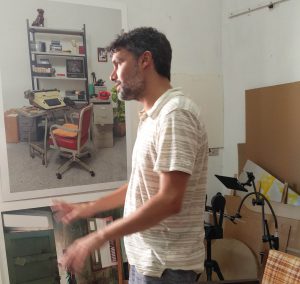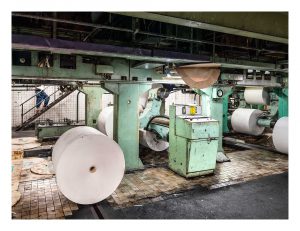The artist Alejandro González shows in his photos his view at the Cuban society. Besides the contemporary look on people, he questions the past and glances as well into a possible future. In July 2016, we met him in his studio in Havana and talked about the first chapter of his series “Re-construction” (2012/13), where he recomposed historical moments of Cuban history. For most Cubans he reminds events of the past, which found their place in the collective memory. Whereas, for many non-Cubans the confrontation with “Re-construction” gives new insights.
At first sight, Alejandro’s photos seem to be documentary pictures. However, entering the artist’s studio, it becomes immediately evident, that he is re-creating a reality and records the constructed scene. On one table, there is a backdrop of an image of his latest series “Re-construction – Gray five-year period”: the opening of the Lenin School in 1974; on another an environment for a new photo, both built out of cardboard. In consequence, the first impression is not to come into a photo studio but into a tinker’s workshop, if there would not be the large-sized pictures of the first Re-construction-series on the walls.
Compared to the “Gray five-year period”, “Re-construction (2012/13)” appears to be more realistic, because the photos seem to show historical daily life scenes: there is the Granma printing hall with its huge paper reels, an office with an old typewriter, or two men looking on a computer monitor. All the images are named by a date, so that a historicity is implied. However, Alejandro reveals directly, that all these photos are arranged and never happened as they are recorded. The date of the title is a reference to a historical event, so its story is reconstructed in the picture.
“Any day of 1965-2012”
“Granma” founded in 1965, is the official newspaper of the Central Committee of the Cuban Communist Party, and the most widely read daily in Cuba. Besides official governmental speeches and announcements, Granma features developments in industry, agriculture, science, arts and sports on the island, Latin America and world politics. In addition, there are articles and sketches about the revolutionary history and its contemporary improvement.
On the photo, there are the paper reels for the Granma. This is the pure material without its conversion into an information carrying media. Since the paper is still virgin, Alejandro shows the moment before the news “are made”. The title refers to the first edition in 1965 and the moment the picture is taken.
“July 7, 1989”
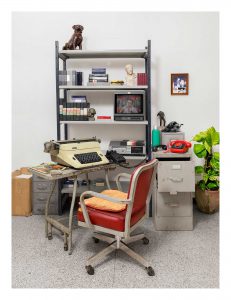 This scene in an office could be a daily situation, where someone left his place, perhaps to call a colleague to the telephone, since one of the receivers is not on-hook and a cigarette smoulders in the ashtray. It is a situation of waiting, as it is very present in many Cuban circumstances. Nevertheless, there are other hints, which refer to the title giving date. The most obvious is the TV-monitor: it shows Arnaldo Ochoa during the trial against him and other “high ranking officers and officials of the Army and the State”. (Dossier A. González, p.69)
This scene in an office could be a daily situation, where someone left his place, perhaps to call a colleague to the telephone, since one of the receivers is not on-hook and a cigarette smoulders in the ashtray. It is a situation of waiting, as it is very present in many Cuban circumstances. Nevertheless, there are other hints, which refer to the title giving date. The most obvious is the TV-monitor: it shows Arnaldo Ochoa during the trial against him and other “high ranking officers and officials of the Army and the State”. (Dossier A. González, p.69)
Arnaldo Ochoa was a highly decorated Cuban general. He joined the guerrilla army in the Sierra Maestra, fought against the Bay of Pigs Invasion and was more than 20 years member of the Communist Party’s Central Committee. Due to his experience, he was sent to many countries as military adviser or commander. His success was recognised by national and international militaries and he was very popular with the Cubans.
Nonetheless, he was accused of corruption and drug smuggle in June 1989. Ochoa confessed, was found guilty and executed the 13th of July 1989. Afterwards followed a wave of purges that concerned many parts of the Cuban society. The trial itself was almost entirely broadcasted on national TV and widely followed by the public.
Besides this general interest in the case, Alejandro was personally affected, because Ochoa was one of his neighbours. Therefore, his testimony is not only historical. That might be the reason, why he inserted more details than usually, hinting to this far-reaching event: on the desk, next to the typewriter, there is an edition of the “Bohemia”. Bohemia is a newsmagazine, which published an extra edition about the process.
The counter of the video player on the shelves shows “1989”. This year is not only the trial year, but as well a starting point to economic decline in Cuba, due to the transformations in the Eastern bloc countries and the tightening of the American embargo. The so-called “Período especial en tiempo de paz” (Special Period in Time of Peace) was characterised by a grave shortage of energy, food and all other vital goods. Also, the so typically Cuban thermos flask might be a reference to the upcoming deficiency.
Moreover, the red telephone, especially in the time of cold war, stands for power. The dog is a symbol for fidelity, since Ochoa was always loyal to Fidel and Raul Castro. In the artist’s personal symbolic, the little Marx sculpture refers to the death sentence.
In retrospect, it seems to Alejandro, that the attention directed to the trial of Arnaldo Ochoa was more like a “fog to hide the reality and distract the people”. (Alejandro González, Havana, 28/07/2016). Besides other events, it might have been the development in Eastern Europe and the USSR, which was not to be focussed too strong. That is as well the subject in the next photo.
“November 9, 1989”
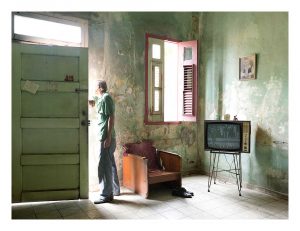 A man stands at the ajar door of a room and looks outside. He holds his left arm angled in front of his upper body as if leaning against the door or as if he wants to protect himself. Bright sunshine from outside illuminates his front and as well the room. Sunny daylight comes in through the window, too.
A man stands at the ajar door of a room and looks outside. He holds his left arm angled in front of his upper body as if leaning against the door or as if he wants to protect himself. Bright sunshine from outside illuminates his front and as well the room. Sunny daylight comes in through the window, too.
The room itself is furnished barely: there is only an armchair, a TV and a photo of a boy on the wall. A pair of shoes stands in front of the armchair. On the TV-screen, there is the image of people standing on the Berlin wall, to celebrate the opening of the German-German border. This is the reference to the photo’s title, even though “the falling of the Wall was never broadcasted by Cuban television.” (Dossier A. González, p. 70) Nonetheless, in the media and society it was spoken about Glasnost and Perestroika, and about the Cuban analogy, the “Rectification”.
Another photo was shot in a TV-studio, from were the not published images of the falling of the wall could have been sent.
“November 22, 2012”
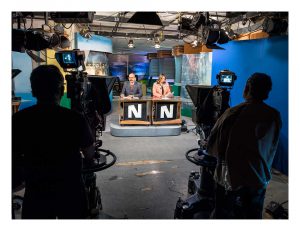 When this picture was made, Agnes Becerra and Rafael Serrano were presenting the news already since 25 years. The National News Bulletin of the Cuban Television (NTV) is broadcasted every evening on prime time. So the two moderators and the emission’s ambience is well known to the people.
When this picture was made, Agnes Becerra and Rafael Serrano were presenting the news already since 25 years. The National News Bulletin of the Cuban Television (NTV) is broadcasted every evening on prime time. So the two moderators and the emission’s ambience is well known to the people.
Alejandro is showing a larger part of the scenery than the normal format. With that, he shows the studio’s reality around the typical section on display. The cameras, spots and cables are visible, and as well the broken floor covering. In consequence, he makes the invisible visible and points out that the clean broadcasted impression is only a part of veracity. He demystifies the emission.
“January 13, 2013”
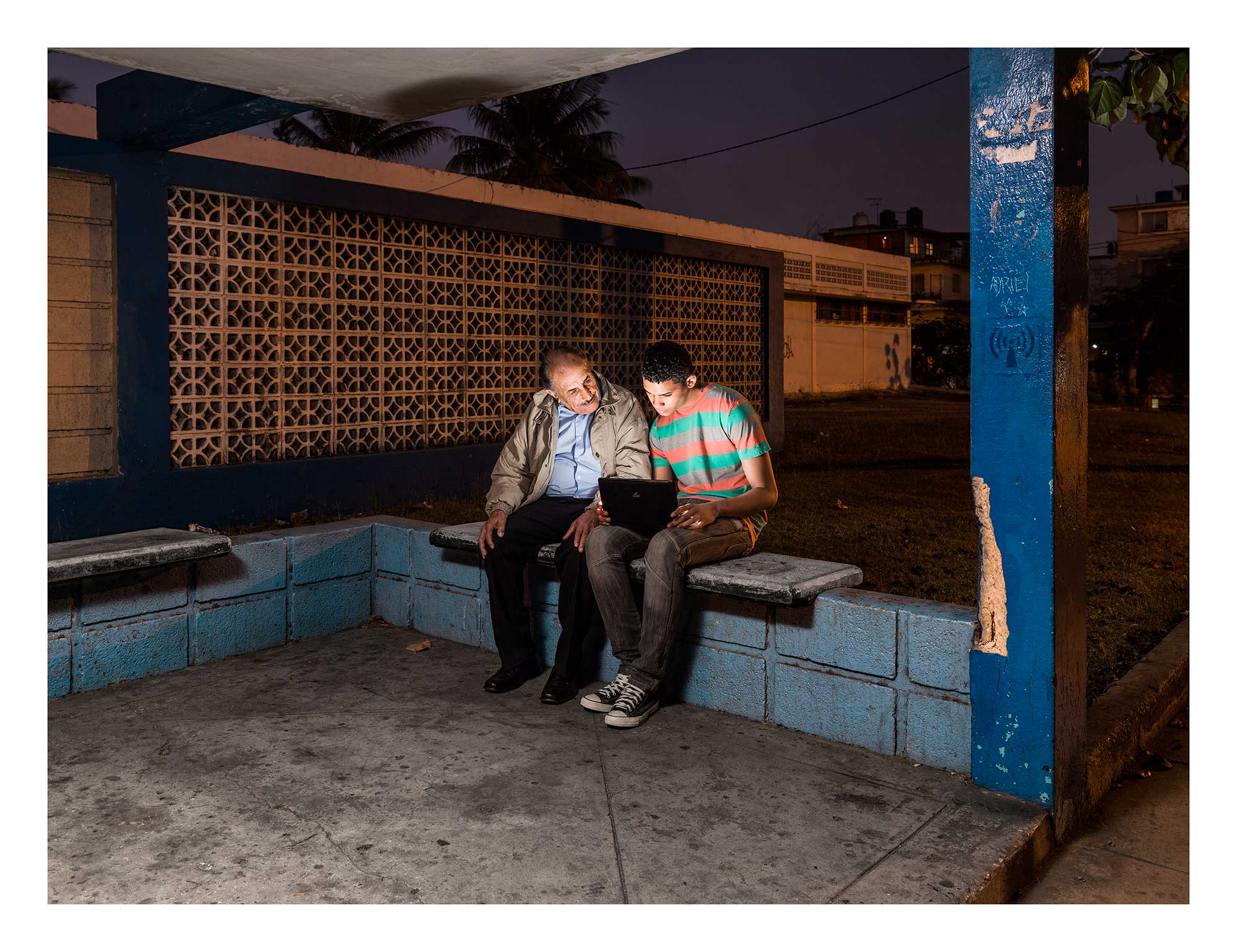 The photo is dated one day after the opening of the first exhibition of “Re-construction”. In consequence, it is a glance into the future. In 2013, the access to the internet was limited to a few service sectors and under stern governmental control. For ordinary people it could have been possible to surf the internet in hotels, if it was not for an unaffordable price of over 50 % of the monthly medium income for an hour of connection.
The photo is dated one day after the opening of the first exhibition of “Re-construction”. In consequence, it is a glance into the future. In 2013, the access to the internet was limited to a few service sectors and under stern governmental control. For ordinary people it could have been possible to surf the internet in hotels, if it was not for an unaffordable price of over 50 % of the monthly medium income for an hour of connection.
In this situation, Alejandro imagined a democratic access to the internet, where the grandson might explain to his grandfather how the internet is working. Privately he even thought of Raul Castro who could be instructed by his own grandchildren. That is why he had chosen the protagonists from different generations and placed them in a public area.
Moreover, the use of the internet is not a value in itself for the artist, but a knowledge transport. One might learn how a healthy nutrition prevents illnesses or learn new languages. Therefore, the access to the internet could help to develop the society.
What seemed to be utopia in 2013 is today mostly reality, even if only few individuals like artists have internet at home. In our days, there are public WiFi areas, where people with the appropriate devices can connect to the internet, but it is still slow and relatively expensive.
More “Re-constructions”
The first series of “Re-constructions” consists six additional photos, besides the five presented ones. In 2014 followed the next chapter: “Re-constructions – The Mega-Projects”. Alejandro showed important ventures that were meant to advance Cuba and save it from underdevelopment, like the only and never finished nuclear power station of Juraguá, province of Cienfuegos (1979-1992) and the Ubre Blanca, a Cuban F2 cow, which produced over three times more milk than a normal cow (1972-1985).
Like yet mentioned, the “Re-construction – Gray five-year period” from 2015 are photos from cardboard environments. This chapter returns to the years between 1970 and 1975, when Cuba found itself constrained to approach economically and ideologically the USSR.
Alejandro González Méndez
Born 1974 in Havana, Cuba, Alejandro made his first steps into photography in the second half of the 1990s. During this time, he frequented workshops directed by Diego Goldberg, Luis González Palma and Edgar Moreno, which explains his dedication to photography since 16 years. In 2000 he debuted with his first solo exhibitions “Quién” (Who) and “Donde” (Where). These two series are showing unidentified people or places in Havana in black and white. So recognised, he took part in group exhibitions in Cuba and as well in Los Angeles (United States) and Tel Aviv (Israel). In 2001 and 2002 followed numerous group shows on both American continents, but also in Europe.
In 2002, Alejandro was invited to an artist-in-residence programme at the Kunsthochschule für Medien (Academy of Media Arts) in Cologne. Therefore, he spent three months in Germany. Besides his continuing participation in national and international exhibitions and art fairs, he created several new works.
Noteworthy in 2005 are “AM-PM”, where he portrays the nightlife in one of Havana’s main streets and “Havana: Future”. For the latter he revisited places where he stayed in his childhood, like the “Tarará Pioneers Camp” and the “Lenin Park”. For the children of the so-called “Generation 2000” – which were said to shape “the man of the future” – these places represent the promised bright prospects of their collective memory. For the first time in Alejandro’s oeuvre, this series points to the past in relation to the present and the future. In his description of these photos he stated: “Either way the future of 20-25 years ago is today, isn’t it?” (Dossier A. González, p. 3)
“Improper Conduct” from 2008 is again anchored in the present. He depicted people, who behave unsuitable to the society concerning their sexual orientation. The portraits were taken at the International Day against Homophobia and a Gay Pride Party and should be seen as condemnation of homophobia. Moreover, it is the claim to decriminalise marginalised groups with other convictions than the majority. “Improper Conduct” formed the eighth personal exhibition of the artist at the Galería Servando, Havana.
Even though “Cuba, año cero” (Cuba, year zero), shot from 2010 to 2012 seems to mirror the contemporary adolescents of Cuba, it is as well a reflexion about the past and the future. The portrayed juveniles could live everywhere in the world, because their stage of life is a universally one of search, discovery, confrontation and conceptual orientation. Nevertheless, they are carrying the countries and the authors past and future in them. These depicted youngsters were all born during the “Período especial” (Special Period), in a time of economical deficiency and social transformation. Therefore, they had never the outlook to promising prospects like the Generation 2000; still they are an important element of the Cuban future. This project was supported by Habana Cultura Visual Art Project Fellowship.
After “Cuba, year zero” Alejandro started with the “Re-constructions”. The “Gray five-year period” and some other pictures of this series were shown in a personal exhibition at the Galleria Art Forum Bologna, Italy in 2015. His works are steadily represented in group shows, art fairs and found their way into public collections in Cuba and the United States.
Alejandro González Méndez lives and works in Havana.
www.alejandrogonzalez-studio.com
He is represented by
Galería Servando, Havana, Cuba
Galleria Art Forum, Bologna, Italy

